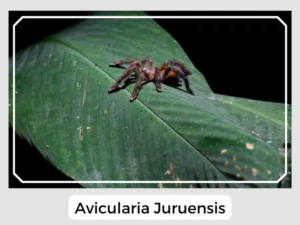Avicularia spiders are part of the tarantula family. While there used to be around 50 types of them, by 2017, only 12 were recorded. What’s super cool about them? They can jump or run really fast when they feel scared. That’s why some people in the rainforests call them ‘flying spiders’.
The number of eggs ranges from 50 to 2,000, deposited in a silken sac.
After hatching, the spiderlings stay in the nest for a few days and feed on egg yolks then.
Like most other species of the tarantula family, the spiders of this genus also do not make webs. However, males of certain species spin a tubular-shaped sperm web.
Yes, Avicularia tarantulas have venom. They use it mainly for catching their food, like little bugs.
Absolutely, they can bite if they’re upset or disturbed. Their bites aren’t typically harmful to people, but they might feel a bit like a pinch
Avicularia tarantulas exhibit crucial ecological behaviors such as pest control. Their diet consists mainly of insects, which helps to regulate insect populations and maintain the biodiversity of their rainforest homes. Their unique ability to jump and run swiftly is not only a defense mechanism but also an adaptation that reflects their arboreal lifestyle, allowing them to escape predators and catch prey.
Natural Predator: In the wild, Avicularia tarantulas face predation from birds, larger mammals, and other spiders. Their survival amidst these threats is indicative of their adaptability and the intricate balance of the rainforest ecosystem.
Prey-Predator Dynamics: These tarantulas employ their venom effectively to subdue insects, which constitutes their primary diet. This interaction is essential for the control of insect populations in their habitat, demonstrating a complex prey-predator dynamic that is vital for the ecological health of their environment.
Relationship with Humans: The relationship between Avicularia tarantulas and humans is one of fascination and respect. While their bites are rare and generally not harmful, they are often kept as exotic pets due to their striking appearance and docile nature. This has led to a greater interest in and awareness of the need to conserve their natural habitats.
| Distribution | South America |
| Habitat | Rainforest and moist areas |
| Diet | Insects |
| Web Type | Sperm web for mating |
| Lifespan | Males: 3-4 years Females: 10-12 years |

In conclusion, Avicularia tarantulas are key rainforest predators, displaying unique behaviors and fostering a delicate coexistence with their human admirers.
Avicularia spiders are part of the tarantula family. While there used to be around 50 types of them, by 2017, only 12 were recorded. What’s super cool about them? They can jump or run really fast when they feel scared. That’s why some people in the rainforests call them ‘flying spiders’.
The number of eggs ranges from 50 to 2,000, deposited in a silken sac.
After hatching, the spiderlings stay in the nest for a few days and feed on egg yolks then.
Like most other species of the tarantula family, the spiders of this genus also do not make webs. However, males of certain species spin a tubular-shaped sperm web.
Yes, Avicularia tarantulas have venom. They use it mainly for catching their food, like little bugs.
Absolutely, they can bite if they’re upset or disturbed. Their bites aren’t typically harmful to people, but they might feel a bit like a pinch
Avicularia tarantulas exhibit crucial ecological behaviors such as pest control. Their diet consists mainly of insects, which helps to regulate insect populations and maintain the biodiversity of their rainforest homes. Their unique ability to jump and run swiftly is not only a defense mechanism but also an adaptation that reflects their arboreal lifestyle, allowing them to escape predators and catch prey.
Natural Predator: In the wild, Avicularia tarantulas face predation from birds, larger mammals, and other spiders. Their survival amidst these threats is indicative of their adaptability and the intricate balance of the rainforest ecosystem.
Prey-Predator Dynamics: These tarantulas employ their venom effectively to subdue insects, which constitutes their primary diet. This interaction is essential for the control of insect populations in their habitat, demonstrating a complex prey-predator dynamic that is vital for the ecological health of their environment.
Relationship with Humans: The relationship between Avicularia tarantulas and humans is one of fascination and respect. While their bites are rare and generally not harmful, they are often kept as exotic pets due to their striking appearance and docile nature. This has led to a greater interest in and awareness of the need to conserve their natural habitats.
| Distribution | South America |
| Habitat | Rainforest and moist areas |
| Diet | Insects |
| Web Type | Sperm web for mating |
| Lifespan | Males: 3-4 years Females: 10-12 years |

In conclusion, Avicularia tarantulas are key rainforest predators, displaying unique behaviors and fostering a delicate coexistence with their human admirers.